Speech Australia in Hock?
It is a pleasure to talk to CEDA again.
Debt is my main topic this evening. Before coming to that, however, I would like to comment briefly on current economic trends.
Current Economic Trends
The economy is emitting mixed but reasonably predictable signals.
Yesterday's national accounts pointed to further strong growth in the September quarter, bringing the rise in GDP over the past year to 3.3 per cent. That growth partly reflects a very welcome rebound in rural production; the growth in the rest of the economy was slightly lower – at 3.1 per cent – but still robust.
Business investment remained at historically high levels and, reflecting our good international competitiveness, exports made a solid contribution.
On the other hand, after being very strong earlier in the year, growth in employment has fallen off in recent months.
The national accounts and employment data are, of course, backward looking. Central bankers have to be forward looking: they have to take a view about economic developments a year or so ahead, when any change in monetary policy would have its full impact. This is always a hard call, not least because economies move in cycles, rather than straight lines.
At the moment, non-farm growth is at the bottom of what is generally considered a sustainable growth rate for Australia of 3–4 per cent. This follows a sharp but necessary adjustment from the unsustainably rapid growth rate of nearly 7 per cent in 1994. Given this adjustment, the recent slowing in employment growth is not unexpected.
We expect economic activity to pick up during 1996 as the effects of some contractionary forces pass through the system:
- First, the downward phase of the housing cycle should start to flatten out, as new construction comes back into line with underlying demand. The earlier excessive rate of construction and rising stocks of unsold houses have been driving the downturn in this sector, not higher interest rates. Mortgage interest rates rose less than the rise in official interest rates in late 1994, and keen competition among lenders has seen rates decline since then. Although the standard variable mortgage rate is 10½ per cent, the average rate actually paid is currently about 9¾ per cent, down from 10 per cent at the end of 1994.
- Second, stocks of non-farm goods also have built up to excessive levels in recent quarters. Efforts are likely to be made to reduce these to more normal levels over the next couple of quarters and, as that adjustment occurs, activity and employment will come under downward pressure.
Housing and stock cycles are integral to the dynamics of economies, and they have to be allowed for in forward looking economic assessments. They imply some further – but temporary – areas of softness in the economy before they have run their course.
Two additional reasons exist for expecting a pick-up in the pace of growth during 1996:
- One is the likelihood that Japan will start to grow again in 1996, after several years of virtually no growth.
- The second is the recovery in farm production. The initial impact of this already has been recorded in yesterday's September quarter national accounts, but the full impact will be felt as farmers receive – and spend – their higher incomes.
The other key determinant in the formulation of monetary policy is the outlook for inflation. As you know, underlying inflation in the year to September – at 3.1 per cent – was a little above our 2–3 per cent objective, which we aim to maintain over a run of years.
With growth in activity and employment now at more sustainable rates, and likely to remain thereabouts over the year ahead, some moderation in price and wage rises can be expected. The large increases in the CPI in the June and September quarters mean, however, that it will take a few quarters yet before the ‘year to’ measure of underlying inflation reflects this moderation; in fact, the ‘year to’ rate could rise further before it eases back towards the 2–3 per cent objective in the second half of 1996.
In summary, current interest rate settings are appropriate for the economic outlook I have sketched. If the accumulation of data were to lead to major changes in that outlook – if, for example, the slowdown were to take on longer-term characteristics, or if growth were to rebound strongly before wage pressures had subsided – then, of course, the stance of monetary policy would need to be reassessed.
Australia's Indebtedness
Policy deliberations in coming months will not be made any easier by the kind of debate which usually precedes an election, and which does little to promote either informed economic discussion or confidence in the economy. We will have to cut through all the hype to get to the truth.
One issue which has already attracted a good deal of media coverage is the extent of indebtedness in Australia. Whether the focus is on foreign debt, government debt or the corporate debt excesses of the late 1980s, the tone is always negative. Perhaps it was ever thus: everyone from Polonius to Micawber has warned against the evil of debt. Few actually live by such admonitions, but many have a sneaking regard for the simple virtue they imply.
The view that debt is always and everywhere a bad thing misses the important point that borrowing allows individuals, companies, governments and nations to pursue opportunities that otherwise would go untapped. A couple can borrow to buy a house and live in it while young, rather than facing a lifetime of saving before buying a house outright in old age. Governments can borrow to build roads, schools and other infrastructure which raises the economy's productive capacity and delivers benefits to both present and future generations.
Shibboleths about debt are, therefore, easily dismissed. But genuine concerns can arise when debt builds up sharply or when capacity to service debt falls off sharply. These concerns give rise to a variety of questions. Are borrowers living beyond their means? Are the borrowings being directed to productive uses? Can the debt be comfortably serviced and repaid? These are all legitimate questions. Experience tells us that borrowers do sometimes miscalculate and get themselves into trouble through being unable to service their debts. The real question is not whether debt is intrinsically ‘bad’, but at what point does it become a worry.
Clearly, at some point debt servicing does become ‘too high’, but there is no ‘magic number’ to trigger warning signals. Fundamentally, it is a matter of assessing the conditions under which debt is accumulated, and coming to a judgment about its sustainability. In this, we should be particularly watchful where, relative to long-term trends:
- the level of debt rises substantially;
- the debt servicing burden rises substantially; and
- asset prices rise sharply.
Against that background, I want to look at what has been happening to debt in four major sectors – namely, companies, governments, households and foreign investors. (Financial institutions also play a role, but theirs is mainly a facilitating – or intermediary – role.)
By way of an overview, if we look at net financial flows among these sectors since the early 1960s (Graph 1), we see that:
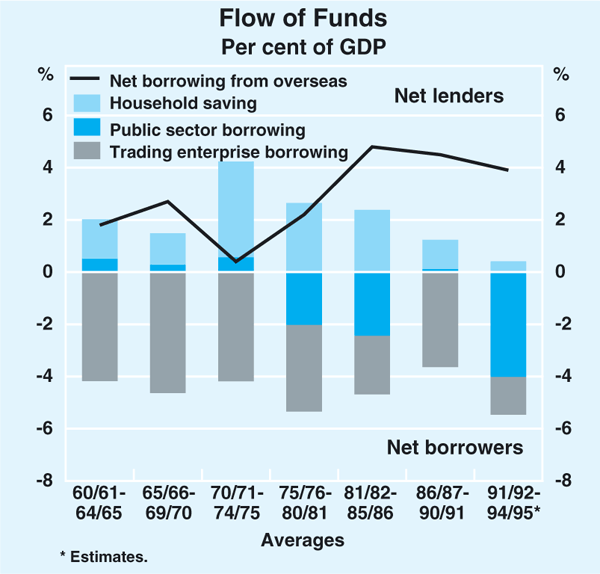
- the corporate sector is a persistent net borrower of funds;
- the public sector was in small surplus through the 1960s and early 1970s, but has been a substantial net borrower over most of the past 20 years;
- the household and overseas sectors have been net providers of funds;
- the household sector is a perennial net lender, but to a diminishing extent; and
- corporates and governments have persistently drawn a substantial proportion of their funding requirements from abroad.
Corporate debt
We start with the corporate sector, which doubled its gross debt in the 1980s, to the equivalent of almost 70 per cent of GDP (Graph 2). This ratio has since declined to around 54 per cent.
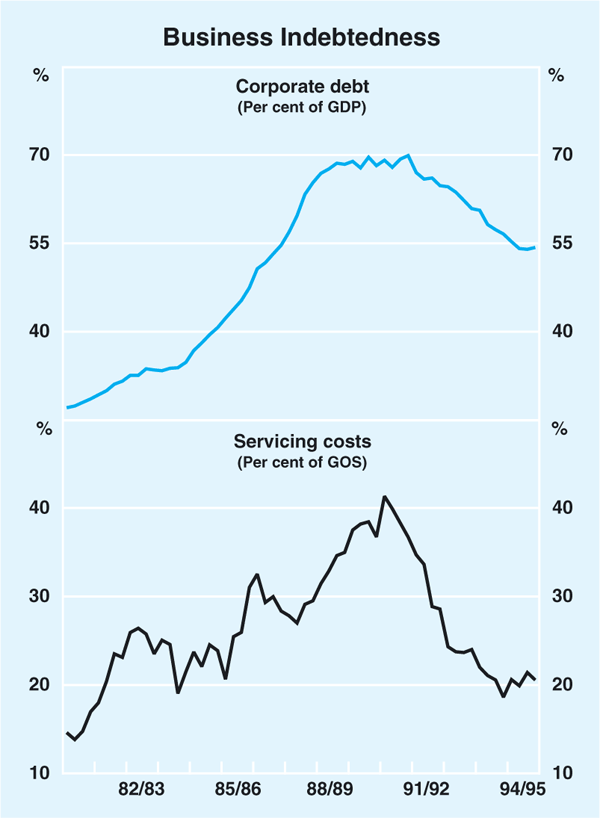
Much of the debt taken on in the late 1980s was in anticipation of continuing rapid rises in asset prices and rapid enrichment of the borrowers. Financial deregulation played handmaiden to speculative activity, facilitating greater access to borrowed funds and leverage.
When asset prices corrected, as they inevitably do, the adjustment was painful, and not just for speculators. Extensive leverage exacerbated financial distress and delayed economic recovery; in many firms, retained earnings were used to retire debt, rather than to finance new investment. The corporate sector's experience in the 1980s stands out as a classic example of a ‘bad’ expansion of debt.
It also highlighted the seductive part played by high inflation in elevating expectations about asset prices and encouraging speculative activity. Assets were acquired with borrowed funds in anticipation of on-going price rises. That, rather than the ‘old fashioned’ route of productive investment, was seen by many businesses and their bankers as a short-cut to wealth.
As debt rose in the 1980s so did the servicing burden, boosted in part by rising interest rates. By the beginning of the 1990s, interest payments represented 40 per cent of gross profits, about double the figure five years earlier. In other words, for every dollar of profit, 40 cents went in interest payments. This situation was not sustainable and it provoked a concerted effort by companies to reduce their indebtedness. As a result of these efforts, aided by lower interest rates, debt servicing has fallen back to about 20 cents in the dollar.
Applying the tests mentioned earlier, corporate debt today is no longer a serious problem. Corporate balance sheets have been repaired, and debt to equity ratios have returned to more normal levels. What is judged to have been genuine productive business investment has been increasing strongly and asset prices have remained fairly subdued.
Government debt
I turn now to government debt, which had been declining as a share of GDP until the late 1970s. It has fluctuated since then, but around a fairly flat trend (Graph 3). Higher budget deficits pushed up the debt level in the early 1990s, but these are now being wound back, and the ratio of public debt to GDP is projected to decline in 1995/96.
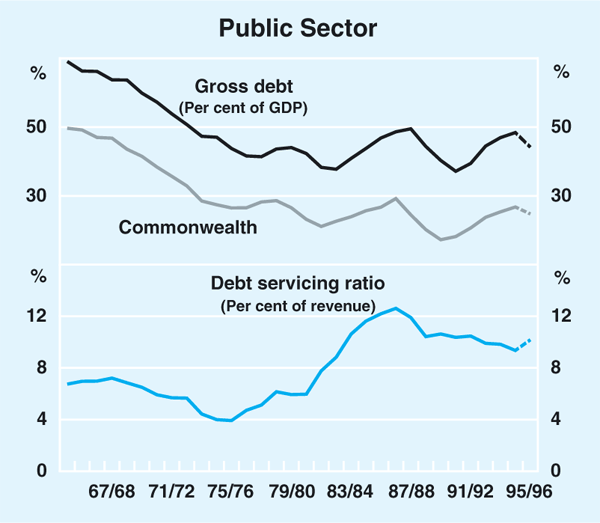
The public debt servicing burden began to rise sharply in the early 1980s, with higher interest rates and a run of large budget deficits. Since the late 1980s, the combination of greater fiscal discipline and generally lower interest rates has seen the servicing ratio fall back to the equivalent of about 10 per cent of government revenues.
It is not widely appreciated, in all the loose talk that one hears about debt, that the gross debt of the general government sector in Australia is about the lowest of any OECD country (Graph 4). On standard international measures, the ratio for Australia in 1994 was 35 per cent, or about half the OECD average. The servicing burden is similarly very low by international standards.
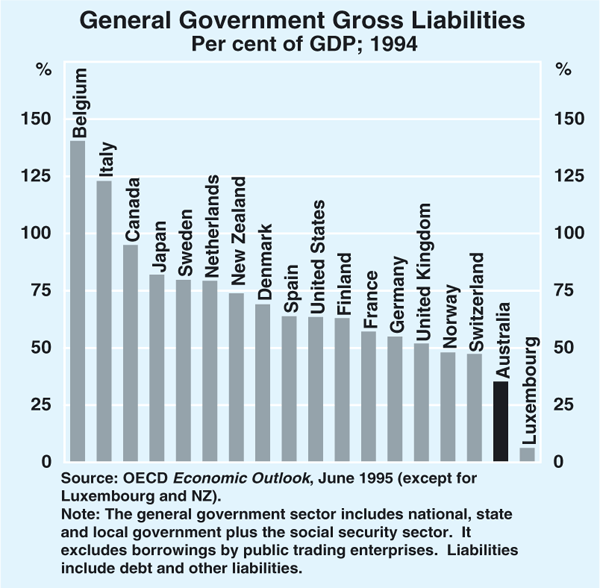
In other words, Australia has not run up large debts through fiscal excesses. We are much better placed than most OECD countries where, typically, chronic budget deficits have generated on-going debt servicing problems and severely curtailed the scope for discretionary fiscal policies.
One measure of Australia's more aggressive fiscal strategy is that, excluding asset sales and other special transactions, the budget is projected to be in virtual balance next year. In the United States, any budget balance appears to be at least seven years away. In Europe, the Maastricht Treaty requires aspiring participants in Stage 3 of Economic and Monetary Union, inter alia, to have government debt to GDP ratios of no more than 60 per cent, and budget deficits of no more than 3 per cent, by 1999. Australia currently satisfies both fiscal tests but, of the European Union countries, only Germany and Luxembourg presently do.
In brief, on all the usual criteria, public sector debt in Australia is well below that in other countries, and both debt and debt service ratios are at manageable levels. But, as impressive as that performance is compared with other OECD countries, it needs to be more impressive because Australia has a greater reliance than most on foreign saving. Indeed, because private saving in Australia is relatively low and difficult to turn around, we need an even larger buffer from public sector saving. I will return to this point later. But first, a look at the household sector.
Household debt
In aggregate, households are net savers – and a source of funds for other sectors – although their contribution to national saving has declined since the 1970s (Graph 1).
Although households are net savers, this net position reflects the outcome of their borrowing and lending, both of which have been rising. After a long period of fairly gradual increases, household debt spurted ahead in the first half of the 1990s (Graph 5). This spurt has been driven by borrowings for housing, and reflects increases in the number of households with housing loans and in average loan sizes. In 1990, the average new housing loan was equivalent to around 165 per cent of annual household disposable income; the comparable figure today is over 200 per cent.
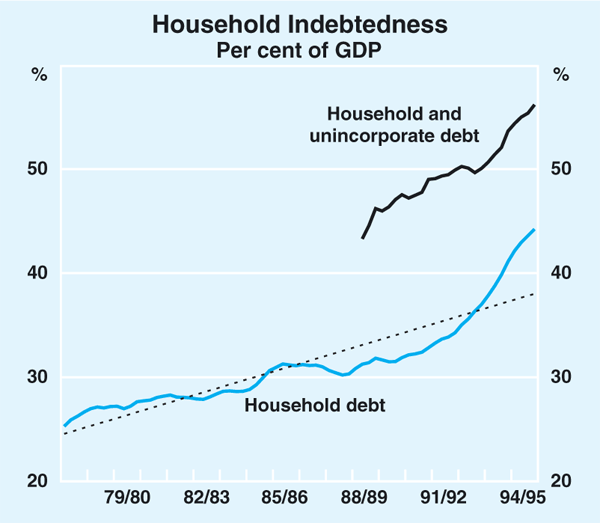
(Unincorporated businesses are usually included with households in the statistics. Like corporations, they too have shed a lot of debt and, as a group, seem reasonably placed to service their current debt levels. This cannot be said, however, of the rural sector. Farmers' cash flows are subject to more vagaries than most, and persistent drought conditions in many areas have resulted in sustained rises in rural debt and debt servicing burdens. Farmers – and, no doubt, their bankers and other creditors – will be heartened by recent drought-breaking rains, but many will require a run of good seasons to repair their balance sheets.)
Gross interest payments by the household sector reached a peak equivalent to about 9.5 per cent of household disposable income in September 1989 (Graph 6). This reflected, in part, the high interest rates at the time and, as rates declined, so too did the debt service ratio. The overall interest burden has picked up again in recent years, but remains below its 1989 peak and appears to be quite manageable.
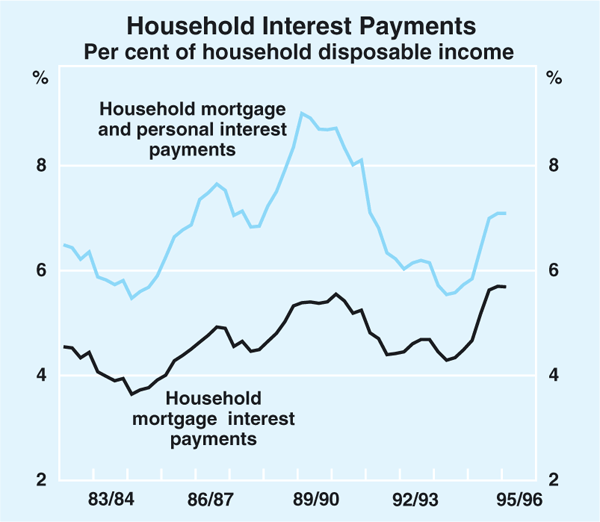
The fact that interest payments remain a relatively low proportion of household income helps to explain why households have increased their gearing in recent years. I suspect that many households would have liked to have taken advantage of the opportunities created by financial deregulation in the late 1980s to the same extent that corporates did, but were precluded from doing so largely by high nominal interest rates then prevailing. In the 1990s, with lower interest rates, households could afford to borrow larger sums, especially for housing. And banks and others have been keen to lend to them.
In effect, Australians have been catching up with households in other countries where relatively low inflation coincided with financial deregulation and led to an earlier rise in household indebtedness. Notwithstanding this recent catch-up, Australian households remain less highly geared than their counterparts in many comparable countries.
While low inflation, and its accompanying low interest rates, make borrowing for housing more affordable (including for low income earners), it also removes some of the traditional gloss of residential investment. With house prices rising less rapidly, the incentive to gear up for speculative gains is less attractive. Moreover, with low inflation, the real debt burden does not fall away as quickly as it did when inflation was high.
Rather ironically, therefore, low inflation has increased individuals' access to debt, but it has diminished the attractiveness of borrowing ‘to the hilt’ to speculate in the housing market. This is a fairly new message but, as it sinks in, I think more people will begin to switch their investments from housing to other productive assets. That will be no bad thing from an economic perspective.
How should we assess household indebtedness at this time? Applying our three tests suggests the following answers:
- Household indebtedness has increased above its longer-term trend. This bears watching, but it is not a cause for alarm. To some extent, the recent rise can be seen as a once-off adjustment to lower inflation. Debt levels remain well below those in the United Kingdom and some other countries in the 1980s, when many households were over-burdened.
- Debt service ratios in Australia are below their peaks of the late 1980s and do not appear excessively burdensome. Default rates on housing loans have increased recently, but from a very low base; the proportion of housing loans falling into arrears is currently about half what it was in the late 1980s.
- The rise in indebtedness has been largely for acquisition of housing, but this has not been associated with rapid inflation of housing prices. Nor, for that matter, is there any evidence of widespread negative equity in housing, as there was earlier in the United Kingdom.
Australia's Overseas Debt
This brings me to the fourth category of debt, namely foreign debt. It is here that we encounter most of the hype about Australia and Australians being in hock. What are the facts?
Australia's net foreign debt is currently equivalent to about 40 per cent of GDP (and about 49 per cent in gross terms). This debt, of course, forms part of the debt of the sectors we have discussed already. In fact, about two-thirds of Australia's foreign debt is owed by business and financial institutions, and one-third by the public sector.
Most of the growth in Australia's foreign debt occurred in the first half of the 1980s, when net debt rose from 6 per cent of GDP to about 35 per cent. The increase since then has been more gradual, peaking at nearly 42 per cent in 1993, before easing back to around 40 per cent in June 1995 (Graph 7).
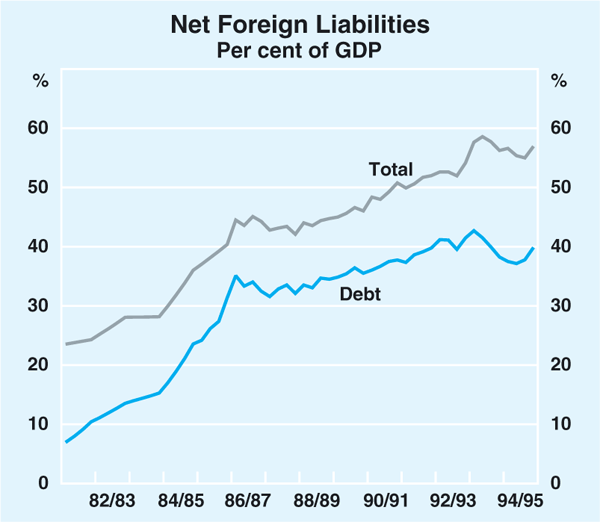
Several factors affect the level of foreign debt, apart from the on-going calls on foreign saving to help finance our investment. Over 50 per cent of the gross debt is denominated in foreign currencies, so changes in exchange rates are obviously important; part of the sharp rise in the mid 1980s reflected the similarly sharp depreciation of the Australian dollar at that time. Switches in the composition of foreign capital inflow between debt and equity are also important.
My focus is on foreign debt, but we should also keep an eye on equity flows. In the 1980s, borrowing replaced a lot of equity and this boosted the growth in debt. In more recent years, we have seen higher rates of equity investment. Equity tends to be more expensive to service than debt but it has certain attractions, one of which is the direct linkage of service (dividend) payments to the profitability of the underlying investment.
How sustainable is our foreign debt?
In terms of levels, Australia's net foreign debt is relatively high by international standards. It is, however, somewhat below that of countries such as New Zealand, Sweden and Canada.
In debt service terms, it is being accommodated. Service payments rose rapidly in the 1980s, from the equivalent of about 5 per cent of exports of goods and services at the beginning of the decade to over 20 per cent at the end (Graph 8). Since then, lower interest rates and good export growth have seen this service ratio almost halved, to about 11 per cent of exports. This is about the same ratio as in the mid 1980s.
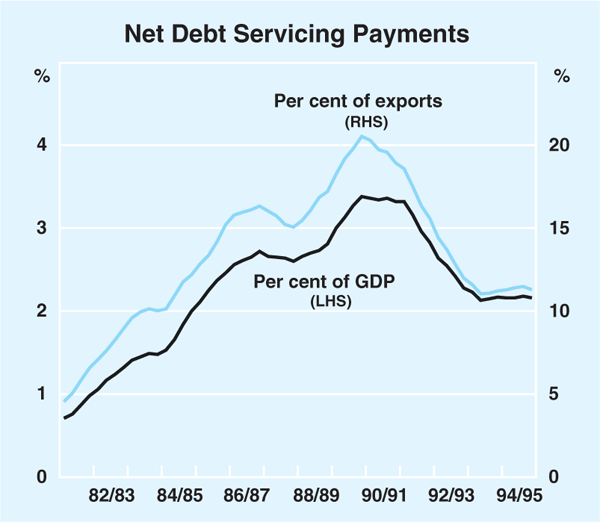
Like other categories of borrowing, the critical factor is whether debt can be serviced adequately. The numbers I have just quoted suggest that Australia's foreign debt is being managed adequately. As with other forms of debt, access to foreign debt can bring benefits, but excessive reliance on it can also bring dangers. Capital flows tend to be increasingly footloose and volatile these days, and high levels of foreign debt can unnerve foreign investors. This brings an additional dimension to foreign debt. Debtor countries are especially vulnerable to the sharp changes which can occur in foreign investor sentiment and capital flows, not always for sound reasons.
This vulnerability means that, while Australia's foreign debt to GDP has broadly stabilised and debt service relative to exports has declined, life would be more comfortable if those ratios were lower. Policy has a role to play here. To begin with, we need to make better use of our existing capital stock; on-going efforts to make the public and private sectors more competitive are contributing to that. But we also need more investment: this means that the main focus of policy action has to be on increasing domestic saving.
In addition to narrowing the domestic saving-investment gap and thereby reducing our potential vulnerability, other, more subjective reasons can be advanced for striving to reduce our reliance on foreign saving. In subtle ways, who owns the capital we use is of some consequence. In tomorrow's world, will the best jobs go to the ‘hewers of wood and drawers of water’, or to the owners of the capital? Will foreign companies be as ready to put Australians in top management positions, or will they prefer their compatriots? Will foreign ownership compromise aspects of national policy? Will we, as a country, feel as content with our lot if the ‘icons’ of Australian production are owned overseas?
I hope I can raise these questions without being accused of beating some kind of jingoistic drum, or – worse – of advocating restrictions on foreign investors or on Australian investments abroad. Rather, I see them as further aspects of the case, pure and simple, for Australians to save more so that we might own more of our assets.
If more proof of this case were required, we need look no further than the fast growing east Asian economies. They have invested prodigiously to achieve this growth, and most of that investment has been funded from their own domestic saving – which, in many cases, is equivalent to one-third or more of GDP, or roughly double the figure for Australia. Growth and saving feed back into each other in a virtuous circle of saving-investment-growth-saving. Theoreticians argue about whether high investment causes high savings or vice versa, but practitioners know that a good saving and investment performance yields strong output and employment growth.
Policy makers in Australia are aware of our saving problem and are moving to tackle it, although the community generally is less seized with the problem. Recent initiatives to increase superannuation contributions will, in time, raise national saving, as will the projected path to budget surpluses. Action on both fronts is critical, but it is in the latter area where, with concerted fiscal discipline, the largest and quickest contributions have to be made. It is also the area where, without such discipline – including in periods around elections – the whole process can most easily unravel. Many people talk a lot about Australia being in hock, but then shy away from the consequences of measures to reduce budget deficits.
Conclusion
In summary, the major sectors of the domestic economy – corporates, government and households – are in reasonable shape financially. They are not manifestly deep in debt, they can service their debt adequately, and they have something to show for that debt in the form of long-lasting assets. At the same time, foreign debt shows signs of levelling out.
Collectively, however, we are not saving enough to finance all the investment we want to make, necessitating substantial overseas borrowings and other calls on foreign saving.
The real issue for Australia in the debt area is not the debt burden of any particular sector, but the macroeconomic task of raising national saving. Policies are now addressing this task. Persistence and patience will be required for these policies to bear fruit.
